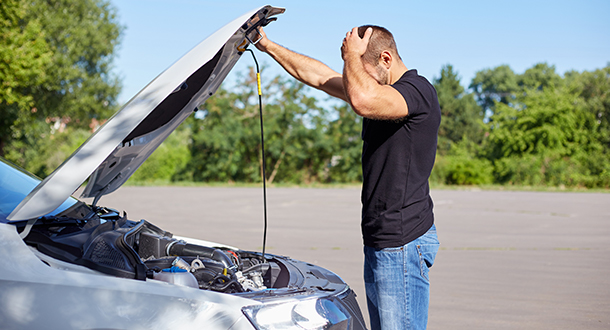
ORLANDO, Fla. (July 20, 2016) – Despite advances in-vehicle technology, including maintenance reminders and other dashboard alerts designed to mitigate roadside trouble, AAA rescued a record-breaking 32 million drivers in 2015, with more battery, flat tire and key problems than ever before, a new study shows. Vehicles fewer than five years old in particular experienced a higher proportion of tire and key-related issues than older vehicles, suggesting that the trend toward eliminating the spare tire and moving to electronic keyless ignitions may have unintended consequences.
“Vehicles today are advanced more than ever, yet are still vulnerable to breakdowns,” said Cliff Ruud, AAA’s managing director of Automotive Solutions. “Sleek, low profile tires are highly susceptible to damage, electronic keyless ignitions can zap battery life and despite advanced warning systems, more than half a million drivers ran out of gas last year.”
Owners of new vehicles may be unaware that some new vehicle designs and features may leave them vulnerable at the roadside. To reduce vehicle weight and boost fuel economy, spare tires are being eliminated from new vehicles at alarming rates, and are being replaced with tire inflator kits that can only remedy some flat tire situations. Additionally, new keyless ignition systems can drain the battery life when keys are stored too close to the vehicle and can lock a driver out of the vehicle while the engine is still running. Finally, despite nearly all new vehicles being equipped with low fuel warning alerts and range estimations, a higher proportion of drivers are using these systems to push the limits between fuel ups.
Other key findings from an analysis of AAA’s 2015 roadside assistance data include:
- Battery failures, flat tires and keys locked inside the vehicle remain the top roadside assistance requests.
- Vehicles fewer than five years old have a higher proportion of tire, key and fuel-related issues than older vehicles. Due in part to complex, electronic vehicle designs, one-in-five service calls for a newer vehicle required a tow to a repair facility.
- Vehicles between 6 and 10 years old have the highest proportion of battery-related issues, as most batteries have a three- to five-year life.
- Roadside assistance calls peak in the summer (8.3 million) followed by winter (8.1 million), fall (7.8 million) and spring (7.7 million).
- Drivers are most likely to request roadside assistance on Mondays and least likely to request assistance on Sundays.
- Drivers in the West experienced the most breakdowns, followed by the South, the Northeast and the Midwest.
- Despite advances in key technology, AAA came to the rescue of more than four million drivers locked out of their vehicles.
“Drivers today have increasingly-connected lifestyles, and want reliable, flexible service options when trouble strikes,” continued Ruud. “AAA has responded with flexible roadside assistance offerings nationwide including app-based service requests and the ability to track assigned service vehicles in real time on a smartphone.”
To help prevent millions of roadside breakdowns from happening, AAA offers the following recommendations for common roadside problems:
- Check for a spare tire: Before purchasing a car, check that the vehicle includes a spare tire. If it doesn’t, consider adding one as an option. Tire inflator kits — which have replaced spare tires on tens of millions of vehicles –cannot remedy all types of tire damage.
- Check tires: At least once a month, check the tire pressure to ensure proper inflation. This affects tire wear and vehicle handling. Tires should be rotated based on the manufacturer’s recommended schedule for the vehicle.
- Lockouts: AAA recommends motorists take special care of their “smart keys” and keyless entry fobs. Always take keys when exiting the car, avoid exposing keyless-entry remote or smart keys to water and always replace the key or fob battery when recommended by the vehicle manufacturer.
- Battery: AAA recommends that drivers have their vehicle’s battery tested when it reaches three years of age and on an annual basis thereafter. AAA’s Mobile Battery Service offers free battery testing for AAA members.
- Pack an emergency kit: A recent AAA survey shows that more than 40 percent of motorists do not carry an emergency kit in their vehicle. AAA recommends that every driver have a well-stocked emergency kit, which includes a mobile phone and car charger; a flashlight with extra batteries; a first-aid kit; drinking water; extra snacks/food for your travelers and any pets; battery booster cables; and emergency flares or reflectors.
Before hitting the road, download the free AAA Mobile app for iPhone, iPad, Android and Apple Watch. Travelers can use the app to request AAA roadside assistance, route a trip, find the lowest gas prices, access exclusive member discounts, book a hotel and more. In addition, AAA members can also track in real time the location of their assigned vehicle with Service Tracker. Learn more at AAA.com/mobile.
As North America’s largest motoring and leisure travel organization, AAA provides more than 56 million members with travel, insurance, financial and automotive-related services. Since its founding in 1902, the not-for-profit, fully tax-paying AAA has been a leader and advocate for the safety and security of all travelers. AAA clubs can be visited on the Internet at AAA.com.
